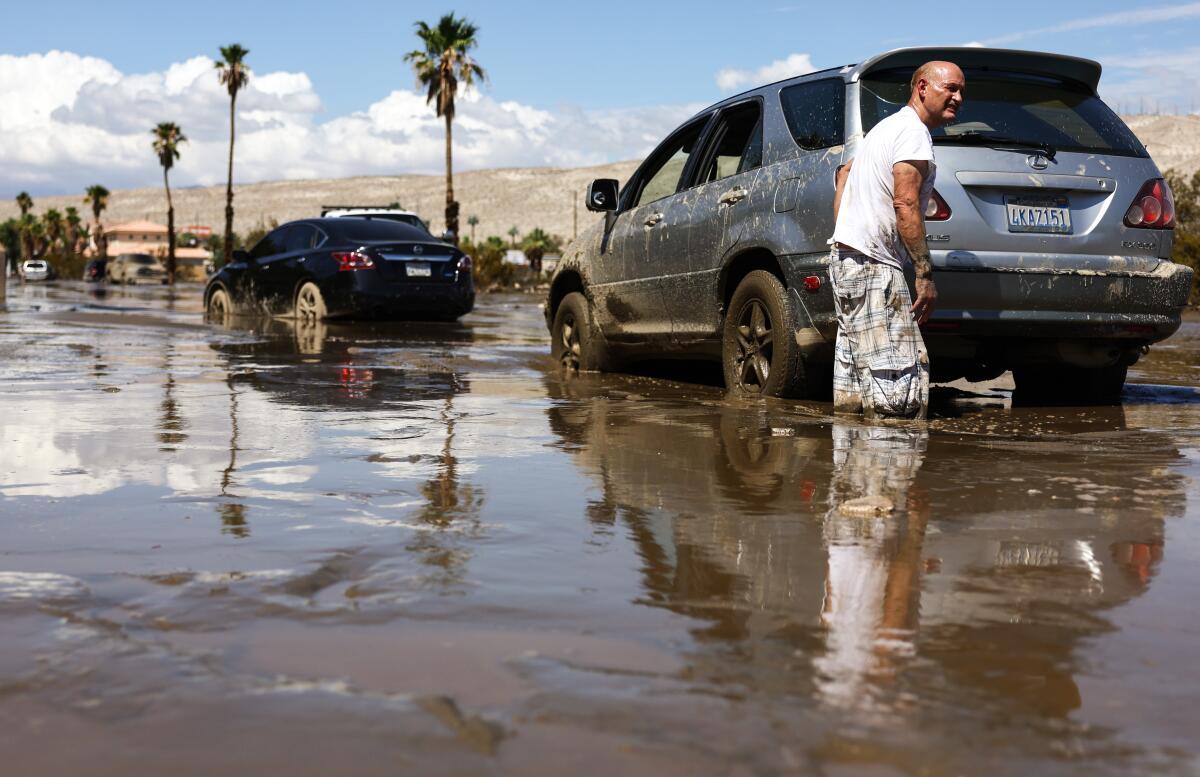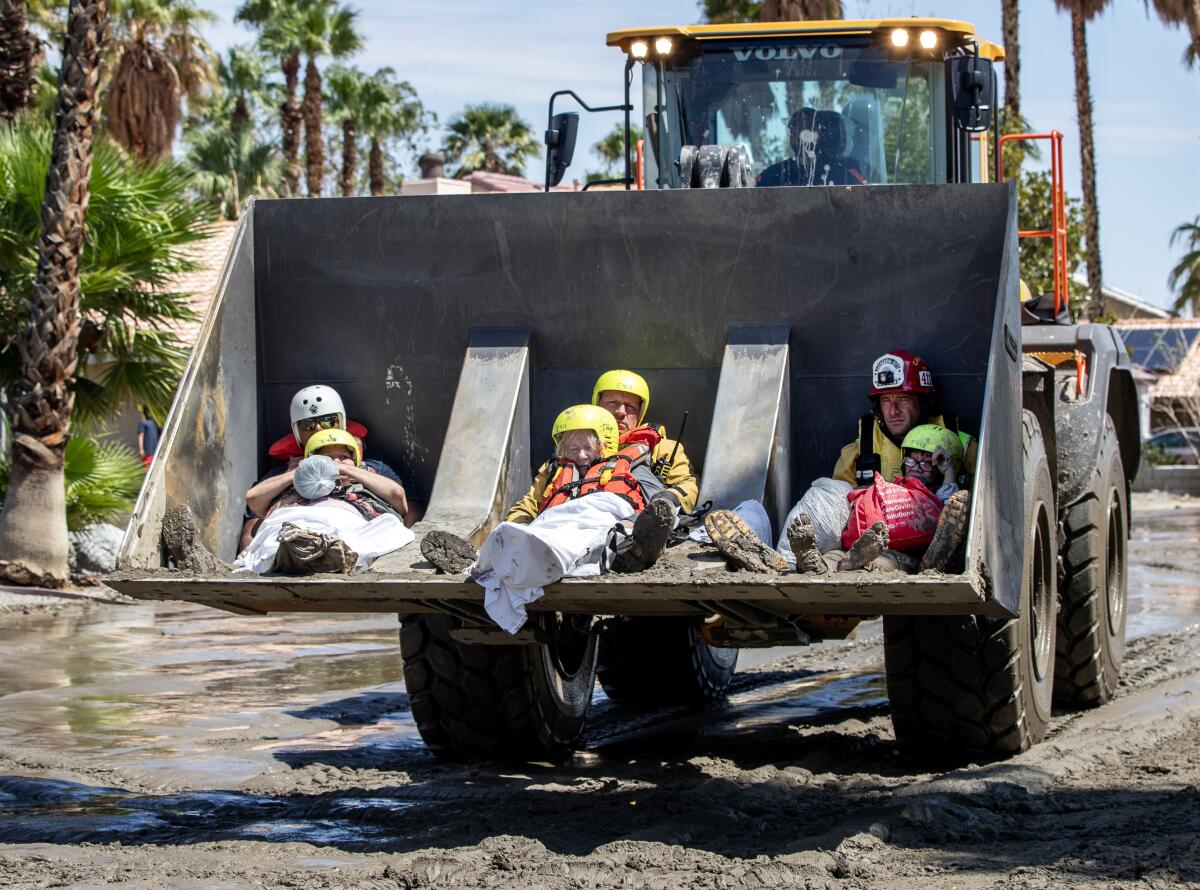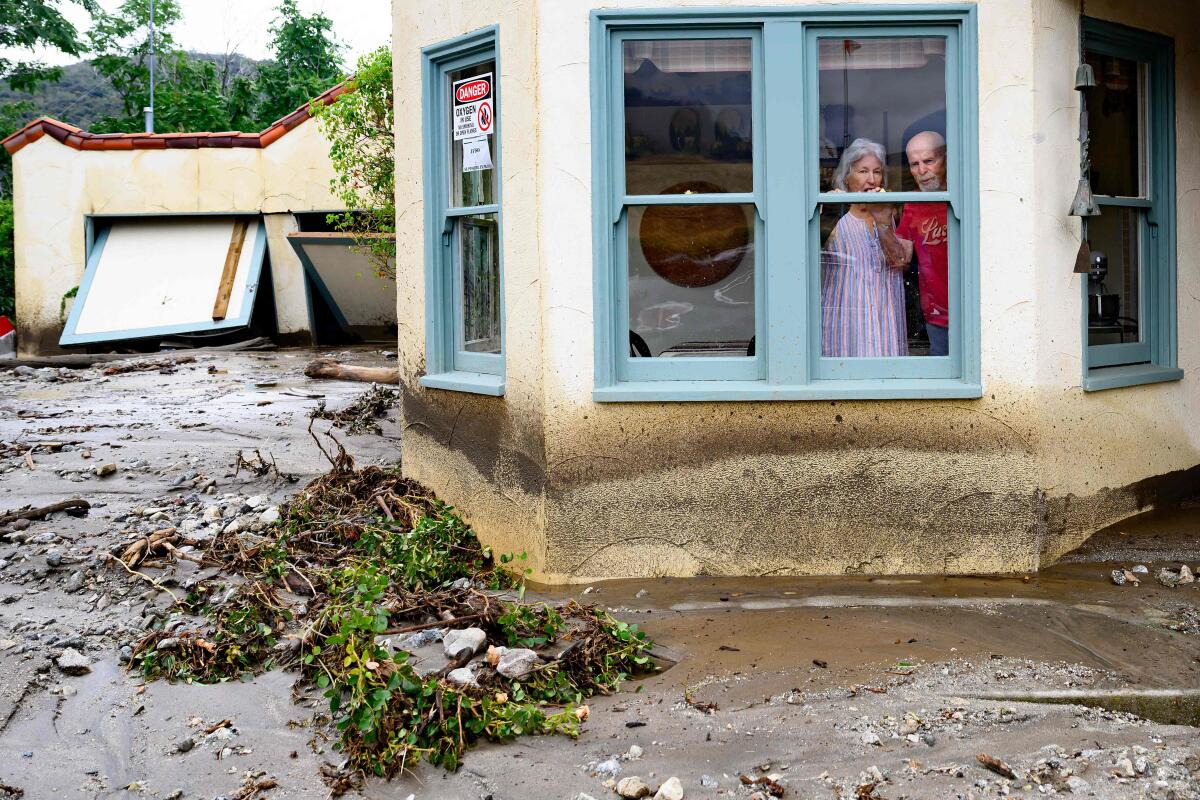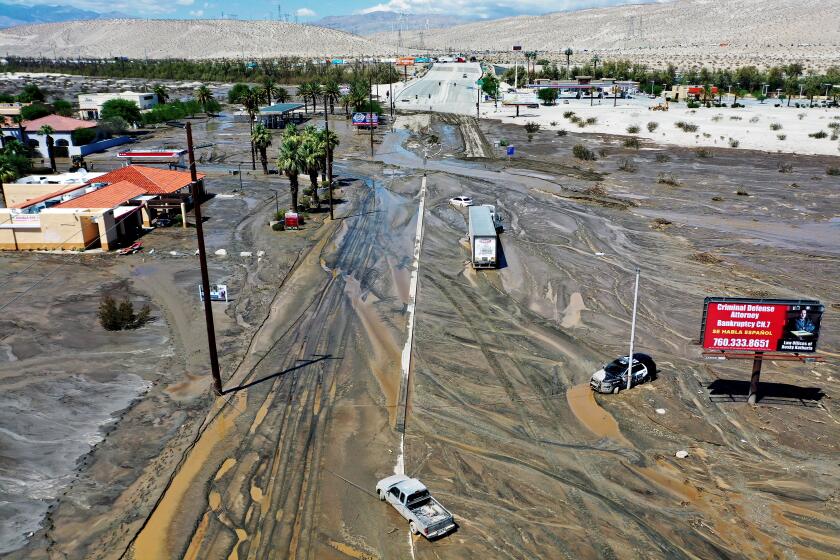They went from 110-degree days to having to dig out after Tropical Storm Hilary slammed California

- Share via
CATHEDRAL CITY, Calif. — It was pitch black as Jimmy Laker steered his full-size pickup truck through deserted, mud-caked streets.
It was just after midnight Monday, a day after Tropical Storm Hilary dumped more than half a year’s worth of rain here in the Coachella Valley.
As he drove through Cathedral City in a chilly drizzle — water flowing on both sides of his Chevy Silverado and mud up to his hood — Laker, 42, was struck by the quiet, broken only by the low rumble of his diesel engine.
Then, as he turned down Horizon Road, he heard shouts.
“Help us!” people hollered from rooftops on both sides. They shined flashlights, trying to get his attention.
Laker and his girlfriend, Cindy Gilissen Smith, spotted an elderly woman, her body caked in mud, curled up outside the front doors of a house. She didn’t look up.
“Are you OK?” Gilissen Smith shouted. “Can we help you?”
“I’m hurt,” she croaked.
While other parts of Southern California emerged drenched but relatively unscathed by Tropical Storm Hilary, the Coachella Valley — a desert region unaccustomed and unprepared for deluge — was left to dig out of the detritus on Monday.

Hilary was well on its way to Las Vegas. In Cathedral City, the late-morning skies were blue. The sun blazed. The heat oppressed. And Laker’s truck, inside and out, was covered in dry, hard mud after hours of rescuing people trapped by the floods.
Laker, a construction worker, has lived in Cathedral City his whole life. He had never seen anything like this storm.
“It’s the desert,” he said. “It doesn’t ever rain here. When it does, it’s insane. They didn’t build any of the roads right here to be able to sustain any water.”
Hilary, the first tropical storm to hit Los Angeles in 84 years, was full of surprises, battering some Southern California areas but sparing others.
In a valley that’s been over 110 degrees for days and weeks on end this summer, it’s hard to believe what he had gone through just hours before.
When they had pulled up to the older woman on her front porch, Gilissen Smith jumped down from the passenger’s side, her new Uggs sucking into the mud, as Laker kept the truck running, fearful water would get into the exhaust and stall it.
The woman was frigid. Gillisen Smith helped her out of her wet clothes and gave her a dry shirt. The couple drove her to a nearby command post and left her in the care of firefighters and paramedics.
As Laker drove several more people out of the inundated neighborhood, the mud thickened. It got harder to drive. His truck’s brakes squealed. Its undercarriage was caked.
“It was a brand new, pretty truck before yesterday,” Lakersaid.

In nearby Palm Springs, 911 lines went down for several hours overnight and in the morning amid a crush of calls about road conditions. Kelly and Michael Baumstark parked their electric bikes under a tree for shade. They had spent the morning riding through the city, checking out the damage. It wasn’t as bad as they expected.
Before Hilary came, the couple stocked up on candles and flashlights. They had their generator ready to go. They drained their pool and put their outdoor furniture under a tarp.
“We had a plan that if it was gonna be bad, we could handle it, but that never really came to true fruition,” said Michael Baumstark, who has lived in Palm Springs for more than 40 years.
By early afternoon, several restaurant patios in downtown Palm Springs were crammed with visitors in bright tank tops and sunglasses, chattering over food that wasn’t stockpiled from Walmart.
As tourists returned to the streets, escaping their hotel rooms, one man sat on a cement ledge in front of the Palm Springs Art Museum, lacing up his damp sneakers.
“The storm hit us bad. I was soaked,” said Nathan Miller, who is 61 and homeless.
Miller said he had been sleeping on sidewalks downtown, of late. When the rain came, he tried to stay under awnings, but water filled his shoes and drenched his clothing. Finally, a business owner let him come inside.
To the north, the Morongo Basin was largely cut off because of road closures Monday.
Jim Dunham, coordinator of the Wonder Valley Community Center, worried that the delivery for his organization’s food bank on Tuesday would not arrive on time.
The monthly event serves around 65 people. The food truck — which usually arrives on Mondays at noon — was trying to get in from State Route 247 from San Bernardino. But portions of it were closed because of flooding and debris.

Dunham was hoping the truck would just be late, rather than a no-show.
His job is to connect residents of Wonder Valley, an unincorporated community east of Twentynine Palms, with services — including grading when roads wash out. He took the community center phone home with him over the weekend, anticipating many requests. To his surprise, he didn’t get a single call, he said.
A large wash empties into Dunham’s yard, which flooded during a heavy, roughly 15-minute downpour around 3 p.m. Saturday.
“I opened the front door and there was a river running into my yard,” he said. “Out here in the desert it just takes 10 minutes. Ten minutes of hard rain and it’s a nightmare.”
Aside from some deep puddles along Amboy Road and spots where the shoulder had given way, there wasn’t much evidence on Monday that a tropical storm blown through.
Dunham said he was surprised the storm wasn’t more catastrophic.
“All the hype?” he said. “Oh my god.”
The food truck, eventually, came.
In Oak Glen — a tiny town of apple orchards and bed-and-breakfasts east of Yucaipa — a creek’s banks overflowed, washing clay, rocks and debris onto the main thoroughfare, Oak Glen Road, which crews on Monday worked to clear.
Men with chainsaws cut up and carried off downed trees in front of family-run orchards that advertised pick-your-own apples outings and American Revolution reenactments. Blackened trees clung to nearby hillsides, and signs warned of an increased risk of flooding in areas that had burned in past wildfires.
As Jane O’Donnell and her husband, Hayden, prepared their two-acre apple orchard Sunday evening, she heard the crashing sounds of stormwater and debris in the creek, “like a train was coming through.”
“It was a rumbling, a groaning,” she said. “It sounded wicked.”
Rocks and sediment were strewn across their Oak Glen orchard, Willowbrook Farm, and another the couple owns in nearby Cherry Valley, called Goodie Farm.
Many apple trees were damaged, O’Donnell said. It couldn’t have come at a worse time: The apple-picking season is about to begin.
In Los Angeles, Mayor Karen Bass on Monday happily reported that there were no known deaths or significant injuries within the city that could be attributed to Tropical Storm Hilary.
“I think if people hadn’t taken it seriously, if people hadn’t prepared, we would have had many more injuries. We would have had deaths, because people would have been on the roadways,” Bass said. “One of the things that we asked them to do was to stay home, and people did stay home.”
The storm turned the oft-dry concrete channel that is the Los Angeles River into, well, an actual, swift-flowing river. It closed schools — including Los Angeles Unified, the nation’s second-largest school district — and downed trees and left thousands without power.
And, on Melrose Avenue, it inundated Dominick DeLuca’s skate shop, Brooklyn Projects.
For hours on Sunday night, he anxiously checked security cameras at the store, peeking at the live stream on his phone. Six o’clock: Nothing. Seven o’clock: Nothing. Eight: Nothing.
Then, around 8:30 p.m., just as he was about to eat dinner, DeLuca checked one last time.
“It was an ocean. An ocean,” he said. “It was flooded.”
More than two feet of water ran over Melrose, he said. It crashed through the front of his 3,600-square-foot store, flowing back to the stockrooms, destroying the Nike sneakers — $130 to $140 a pair — that he was going to release Saturday.
He figured he’d lost $12,000 in merchandise.
DeLuca said that stretch of Melrose, near Vista Street, is prone to flooding and was repeatedly inundated during this winter’s heavy rains. He said he has had trouble getting city crews to come open drain covers to let more water pour in, and has had to call the fire department several times to do so.
On Monday, workers in his store swept water out of the building. Wet Nikes and clothes lay outside, drying.
“I don’t know how we’re going to come back from this one,” he said. “It sucks.”
In Newport Beach, Keith Schleicher sat in a beach chair in the sand, next to his wife, Jennifer. They watched the waves, soaking in the sun.
The couple, from Buffalo, N.Y., traveled to Orange County last week. Keith was supposed to be on a business trip, but his training session was cancelled because of the storm. So, they hit the beach.
“It was a little cold this morning,” Jennifer, 55, said. “But it’s beautiful now. We’re going to enjoy it.”
Keith, 56, smiled.
“What hurricane?”
Times staff writers Alexandra E. Petri, Grace Toohey, David Zahniser, Keri Blakinger, Connor Sheets, Hannah Fry, Rong-Gong Lin II, Louis Sahagún, Brennon Dixson and Faith E. Pinho contributed to this report.
More to Read
Sign up for Essential California
The most important California stories and recommendations in your inbox every morning.
You may occasionally receive promotional content from the Los Angeles Times.



















